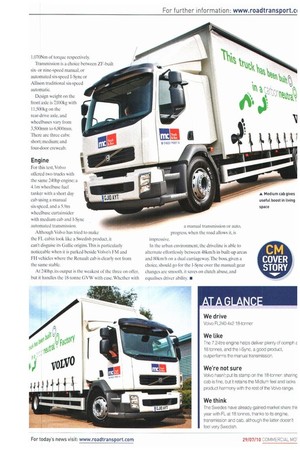Going up market
Page 34

Page 35

If you've noticed an error in this article please click here to report it so we can fix it.
Volvo trucks have never been the biggest sellers in the 18-tonne market, but, with a revised cab, the FL puts quality over quantity.
Words: Kevin Swallow After nearly 25 years in the two-axle market. Volvo Trucks remains on the outside looking in.The Swedish manufacturer has continually failed to trouble market leader DAF, but with a market share in the 18-tonner market of more than 12% in the first six months of 2010—up 2% on last year — it is making progress.
This puts Volvo in the chasing pack along with Mercedes-Benz and Scania. Its popularity is twofold: the cab and existing customers. Sharing cab specifications with its sister firm Renault Trucks has won over many operators who might, in the past, have shied away from the dated FL cab. And with a decent product in this weight range, customers using the heavier FM or FH models can drop down to the FL without compromising on quality
Overweight
The FL arrived in 1986 as an overweight and unsuccessful 7.5-tonner and, until the link with Renault in 2006, had gone through every variation through to 8x4 tipper. Today, it is available at 12 tonnes (FL L); between 15 tonnes and 16 tonnes (FL M); and at 18 tonnes (FL H).
The FL H is powered by a Deutz-built 72-litre, six-cylinder turbocharged engine, using SCR to hit Euro-5, which produces 240hp, 260hp and 290hp with 940Nm,1,010Nm and 1,070Nm of torque respectively.
Transmission is a choice between ZF-built sixor nine-speed manual, or automated six-speed I-Sync or Allison traditional six-speed automatic.
Design weight on the front axle is 7,100kg with 11,500kg on the rear-drive axle, and vvheelbases vary from 3,500mrn to 6,800mm. There are three cabs: short: medium; and four-door crewcab.
Engine
For this test, Volvo offered two trucks with the same 240hp engine; a 4.1m wheelbase fuel tanker with a short day cab using a manual six-speed, and a 5.9m wheelbase eurtainsider with medium cab and 1-Sync automated transmission.
Although Volvo has tried to make the FL cabin look like a Swedish product, it can't disguise its Gallic origins. This is particularly noticeable when it is parked beside Volvo's FM and FH vehicles where the Renault cab is clearly not from the same stable.
At 240hp. its output is the weakest of the three on offer, but it handles the 18-tonne GVW with ease. Whether with a manual transmission or auto, progress, when the road allows it, is impressive.
In the urban environment, the driveline is able to alternate effortlessly between 48ktn/h in built-up areas and 80km/h on a dual carriageway. The boss, given a choice, should go for the I-Sync over the manual; gear changes are smooth, it saves on clutch abuse, and equalises driver ability. •




























































































































